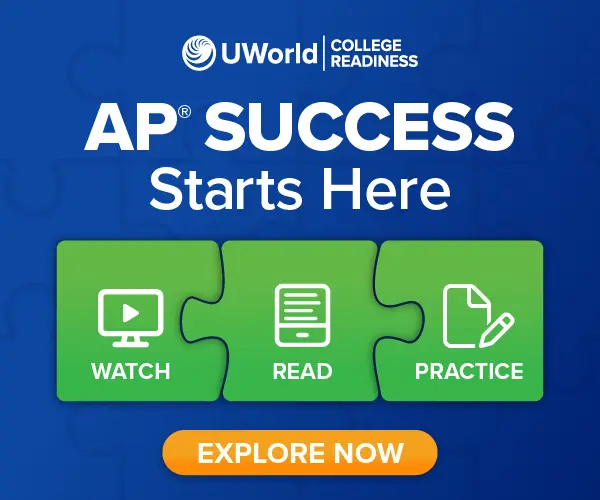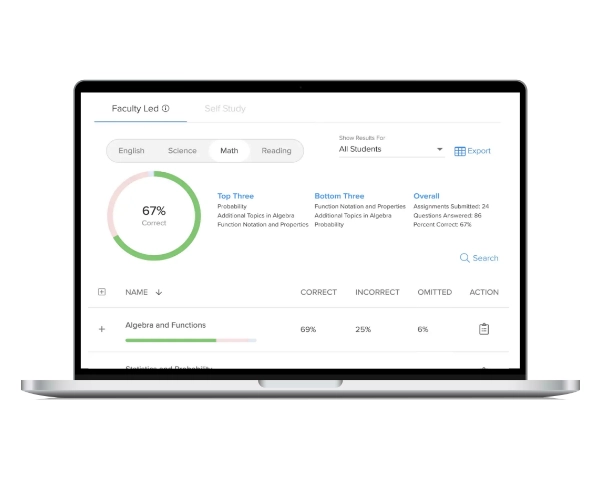Education technology: friend or foe in the Advanced Placement (AP®) classroom? On the “Easy EdTech Podcast,” Philip Bates, UWorld's Director of College Readiness, joins Dr. Monica Burns to share invaluable insights into technology's place in high school education in the episode “Using EdTech to Set AP Students Up for Success.”
Discover notable takeaways from their conversation and additional strategies and resources to empower AP learners and maximize digital resources in AP classrooms.
Why EdTech Matters for AP Student Success
AP classes involve rigorous college-level coursework in a high school environment. Students who earn an AP exam score of 4 or 5 (or 3 in some cases) earn college credit, saving precious time and money on higher education. However, not every young learner is equipped to handle the lofty demands of AP. Those who struggle often lack targeted support, academic confidence, and tailored learning.
Fortunately, AP teachers can address these challenges by using EdTech responsibly.
Supporting Early Intervention & Continuous Monitoring
The Challenge
A well-known truth about AP education is that when students face ongoing challenges, many choose not to take the AP exam, while others withdraw from the class altogether. That's why early intervention and continuous monitoring of student performance are necessary. Those who begin to show signs of academic difficulties can benefit from exercises and activities that fill knowledge gaps and help students keep pace. But how can educators adequately identify these struggling learners? The answer lies in instructional technology optimized for the AP environment.
The EdTech Solution
AP educators bring various instructional talents into the classroom, including keen evaluative skills. They are adept observers of their students and can quickly determine who is progressing and who is facing obstacles.
To complement this ability, teachers can incorporate digital reporting measures, which provide real-time data, diagnostics, and centralized tracking of academic indicators. By leveraging this instructional technology, teachers will receive a more holistic picture of student successes and weaknesses. This allows them to target their instruction to reinforce vital habits like active reading, annotation, or evidence-based writing.

Building Academic Confidence
The Challenge
To thrive in the AP classroom, students must become skilled problem solvers. This means learning to read for meaning, write with evidence, and think critically about complex ideas. When students arrive without these core competencies, it's easy to label them as “unprepared.” However, recognizing that this is a crucial teaching opportunity is paramount, as the ideal AP classroom supports learners at all levels.
One of the most effective ways to do this is by fostering a growth mindset through productive struggle. Essentially, students attempt to make sense of complex ideas and relationships just beyond their understanding. In the modern AP classroom, that productive struggle becomes far more manageable and impactful with the right EdTech tools.1
The EdTech Solution
Instructional technology for building academic confidence can help students engage more deeply with content, especially when grounded in inquiry-based learning strategies like project-based assignments and free-response questions (FRQs).
These activities prompt students to ask questions such as:
- How did I arrive at this answer?
- What steps did I take?
- What's the relationship between these concepts?
This type of thinking develops higher-order reasoning skills, allowing students to spot patterns and expand their knowledge. The result? Increased confidence in the AP classroom.

Differentiation in AP Classes
The Challenge
A common misconception is that AP classes are homogeneous, but this couldn't be further from the truth. Students enter the classroom with diverse aptitudes, abilities, and prerequisite skills. Even the highest-achieving learners bring knowledge gaps — the key to recognizing those gaps is constant formative assessment.
The EdTech Solution
Given their time constraints, AP teachers cannot address each student's misconception on a missed question and provide individual mini-lessons. Fortunately, EdTech has targeted this pain point with digital material that offers immediate feedback. Students can fill knowledge gaps with focused study, and educators can maintain their instructional momentum. When it features highly responsive content to student needs, EdTech differentiates classrooms and greatly enhances student engagement.

Enhancing AP Instruction with EdTech
EdTech tools for teachers are intended to enhance AP instruction, not replace it. It does this by identifying students who are struggling academically, building student confidence through productive struggle, and differentiating AP classrooms by providing individualized feedback. When students approach challenging AP content with stronger skills and greater confidence, they're more likely to stay enrolled — and succeed.
Frequently Asked Questions (FAQs)
How can EdTech support early intervention in AP classes?
Digital reporting and diagnostics provide teachers with real-time data on student progress. This allows educators to spot early warning signs so they can address knowledge gaps and continuously monitor student performance. See Supporting Early Intervention & Continuous Monitoring.
How can technology build academic confidence in AP students?
AP students often wrestle with challenging material, and confidence grows when they feel supported through productive struggle. EdTech makes this possible with ready-made practice activities, FRQs, and engaging project-based assignments, allowing learners to recognize patterns and develop higher-order reasoning skills. See Building Academic Confidence.
What is “productive struggle,” and why is it important in AP learning?
Productive struggle occurs when students engage with ideas and relationships that are just out of reach. Working through challenging AP content helps students develop resilience and enhanced knowledge retention. See Building Academic Confidence.2
How does EdTech help differentiate instruction in AP classrooms?
Since AP classrooms include students with varied skill levels, EdTech tailors learning by providing individualized feedback and targeted practice. This ensures every student gets the support they need without slowing down the class pace. See Differentiation in AP Classes.
What are the best podcasts for teachers to get professional insights?
Educators can gain quick, practical takeaways from podcasts that fit easily into their busy schedules. Top picks include “From Classroom to Campus” for insights on college readiness, “Cult of Pedagogy” for research-based teaching strategies, and “10-Minute Teacher” for fast, actionable tips. Each offers a balance of inspiration and practicality, making them ideal companions for professional growth. For more information about these selections, explore our favorite educator podcasts.
What is the best EdTech resource for AP instruction?
The most effective EdTech resources for AP instruction combine realistic practice, detailed answer explanations, and actionable feedback. UWorld’s Courses for AP are a top choice because they offer expert-written questions, in-depth rationales, and insightful reporting to help track course performance and progress toward exam readiness.
References
- Roth, J. A. (2019). Making the struggle productive: Conceptualizing the role and impact of the mathematics teacher in episodes of productive struggle (Doctoral dissertation, Kennesaw State University). Kennesaw State University Digital Commons. https://digitalcommons.kennesaw.edu/seceddoc_etd/16/
- Smith, D. (2020, April 12). The neuroscience behind productive struggle. Edutopia. https://www.edutopia.org/article/neuroscience-behind-productive-struggle












